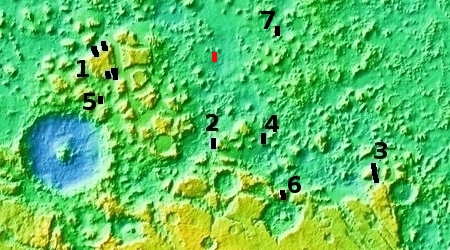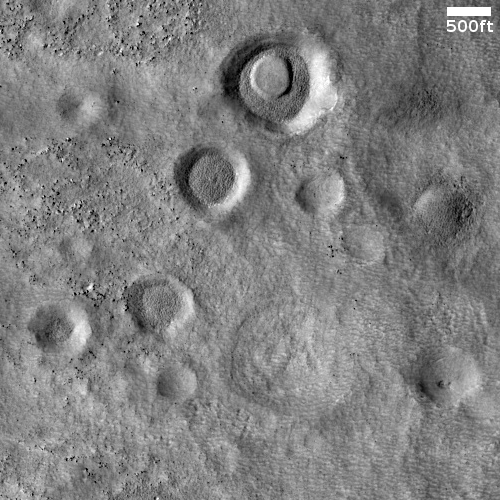Ice-filled craters in Mars’ glacier country?
Today’s cool image returns us to the chaos region dubbed Protonilus Mensae, the middle of three adjacent mensae regions in the northern hemisphere that I like to dub Mars’ glacier country because there is so much evidence of buried ice there.
The photo to the right, cropped to post here, was taken on May 31, 2021 by the high resolution camera of Mars Reconnaissance Orbiter (MRO). Titled “Layered Feature in Crater in Protonilus Mensae,” the section I have posted focuses on several craters, with the one with the central mesa likely the picture’s target. Based on many similar features found in craters in this region, it is somewhat safe to assume that this mesa is made of buried ice.
The overview map below as always provides the context.

The red box marks the location of this particular picture. The numbered black boxes indicate cool images in this region that I have previously featured:
- 1. Buried glaciers flowing off of Martian mesa
- 2. Brain Terrain on Mars
- 3. How to spot a glacier on Mars
- 4. Glacier country on Mars
- 5. Revisiting Mars’ glacier country
- 6. Back to Mars’ glacier country
- 7. A cracking Martian glacier?
I’ve noted this previously, but almost every high resolution picture taken by MRO in this region shows some evidence of glacial features. The accumulating images above illustrate this point.
It is very possible that the mesa in this crater is not glacial. However, the soft look of all the craters in this picture, including the full image, suggest an ice-rich terrain with that ice close to the surface.
The global map below gives a wider context, for those planning their own Mars colonization project.

Click for high resolution version.
The two hatched lines at 30 degrees north and south indicate the closest to the equator such glacial features have been identified. The areas outlined in white note regions like Protonilus Mensae where glacial features dominate.
Where would you land? SpaceX is favoring Amazonis Planitia, because it is both flat and ice-rich. I might prefer western Utopia Basin, because it also appears ice rich, is flat, and is relatively close to glacier country as well as a very mineral rich region due north of Perseverance’s landing site in the transition zone between the northern lowlands and the cratered southern highlands.
On Christmas Eve 1968 three Americans became the first humans to visit another world. What they did to celebrate was unexpected and profound, and will be remembered throughout all human history. Genesis: the Story of Apollo 8, Robert Zimmerman's classic history of humanity's first journey to another world, tells that story, and it is now available as both an ebook and an audiobook, both with a foreword by Valerie Anders and a new introduction by Robert Zimmerman.
The print edition can be purchased at Amazon or from any other book seller. If you want an autographed copy the price is $60 for the hardback and $45 for the paperback, plus $8 shipping for each. Go here for purchasing details. The ebook is available everywhere for $5.99 (before discount) at amazon, or direct from my ebook publisher, ebookit. If you buy it from ebookit you don't support the big tech companies and the author gets a bigger cut much sooner.
The audiobook is also available at all these vendors, and is also free with a 30-day trial membership to Audible.
"Not simply about one mission, [Genesis] is also the history of America's quest for the moon... Zimmerman has done a masterful job of tying disparate events together into a solid account of one of America's greatest human triumphs."--San Antonio Express-News
Today’s cool image returns us to the chaos region dubbed Protonilus Mensae, the middle of three adjacent mensae regions in the northern hemisphere that I like to dub Mars’ glacier country because there is so much evidence of buried ice there.
The photo to the right, cropped to post here, was taken on May 31, 2021 by the high resolution camera of Mars Reconnaissance Orbiter (MRO). Titled “Layered Feature in Crater in Protonilus Mensae,” the section I have posted focuses on several craters, with the one with the central mesa likely the picture’s target. Based on many similar features found in craters in this region, it is somewhat safe to assume that this mesa is made of buried ice.
The overview map below as always provides the context.

The red box marks the location of this particular picture. The numbered black boxes indicate cool images in this region that I have previously featured:
- 1. Buried glaciers flowing off of Martian mesa
- 2. Brain Terrain on Mars
- 3. How to spot a glacier on Mars
- 4. Glacier country on Mars
- 5. Revisiting Mars’ glacier country
- 6. Back to Mars’ glacier country
- 7. A cracking Martian glacier?
I’ve noted this previously, but almost every high resolution picture taken by MRO in this region shows some evidence of glacial features. The accumulating images above illustrate this point.
It is very possible that the mesa in this crater is not glacial. However, the soft look of all the craters in this picture, including the full image, suggest an ice-rich terrain with that ice close to the surface.
The global map below gives a wider context, for those planning their own Mars colonization project.

Click for high resolution version.
The two hatched lines at 30 degrees north and south indicate the closest to the equator such glacial features have been identified. The areas outlined in white note regions like Protonilus Mensae where glacial features dominate.
Where would you land? SpaceX is favoring Amazonis Planitia, because it is both flat and ice-rich. I might prefer western Utopia Basin, because it also appears ice rich, is flat, and is relatively close to glacier country as well as a very mineral rich region due north of Perseverance’s landing site in the transition zone between the northern lowlands and the cratered southern highlands.
On Christmas Eve 1968 three Americans became the first humans to visit another world. What they did to celebrate was unexpected and profound, and will be remembered throughout all human history. Genesis: the Story of Apollo 8, Robert Zimmerman's classic history of humanity's first journey to another world, tells that story, and it is now available as both an ebook and an audiobook, both with a foreword by Valerie Anders and a new introduction by Robert Zimmerman.
The print edition can be purchased at Amazon or from any other book seller. If you want an autographed copy the price is $60 for the hardback and $45 for the paperback, plus $8 shipping for each. Go here for purchasing details. The ebook is available everywhere for $5.99 (before discount) at amazon, or direct from my ebook publisher, ebookit. If you buy it from ebookit you don't support the big tech companies and the author gets a bigger cut much sooner.
The audiobook is also available at all these vendors, and is also free with a 30-day trial membership to Audible.
"Not simply about one mission, [Genesis] is also the history of America's quest for the moon... Zimmerman has done a masterful job of tying disparate events together into a solid account of one of America's greatest human triumphs."--San Antonio Express-News


